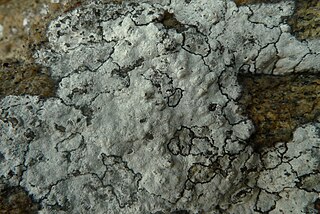
The Arthoniales is the second largest order of mainly crustose lichens, but fruticose lichens are present as well. The order contains around 1500 species, while the largest order with lichenized fungi, the Lecanorales, contains more than 14000 species.

The Arthoniaceae are a family of lichenized, lichenicolous and saprobic fungi in the order Arthoniales. The Arthoniaceae is the largest family of Arthoniales, with around 800 species. Most species in Arthoniaceae belong in Arthonia which is the largest genus with 500 species. The second and third largest genus is Arthothelium with 80 species, and Cryptothecia with 60 species.

The Roccellaceae are a family of fungi in the order Arthoniomycetes. Most taxa are lichenized with green algae, although some are lichenicolous, growing on other lichens.

The Stictidaceae are a family of fungi in the order Ostropales. It has 30 genera and about 240 species.

Badimiella is a genus of lichen-forming fungi in the family Pilocarpaceae. It has two species of foliicolous (leaf-dwelling) lichens.

Roccella is a genus of 23 species of lichens in the family Roccellaceae. The genus was circumscribed by Swiss botanist Augustin Pyramus de Candolle in 1805, with Roccella fuciformis as the type species.

Roccellographa is a genus of lichen-forming fungi in the family Roccellographaceae. The genus was circumscribed by Austrian lichenologist Julius Steiner in 1902, with Roccellographa cretacea assigned as the type, and at that time, the only species. Three additional species have since been transferred to the genus from other genera.

Lecanographaceae is a family of mostly lichens in the order Arthoniales. The family was circumscribed in 2014, prompted by a molecular phylogenetic-based restructuring of the Arthoniales.

Opegraphaceae is a family of lichen-forming and lichenicolous fungi in the order Arthoniales. It was originally proposed by German lichenologist Ernst Stizenberger in 1862. It fell into disuse, but was resurrected in a molecular phylogenetic study of the order Arthoniales published in 2010. It now includes taxa that were previously referred to the family Roccellaceae, its sister group.
Vigneronia is a genus of lichen-forming fungi in the family Roccellaceae. It has five species. The genus was circumscribed in 2014 by Damien Ernst, with Vigneronia spieri assigned as the type species. This species, originally described as Schismatomma spieri from collections made in the Galápagos Islands, has since been recorded from mainland Ecuador and the Antilles (Curaçao). The genus is named after Ernst's wife, Nathalie Vigneron, who accompanied him on collecting trips.
Gyrographa is a genus of lichen-forming fungi in the family Roccellaceae. The genus was circumscribed in 2014 by Damien Ernst and Anders Tehler, with Gyrographa gyrocarpa assigned as the type species. This lichen, originally described by Julius von Flotow in 1825, was first placed in the genus Opegrapha. Species in the genus have a crustose thallus lacking a cortex, and a dark brown prothallus. The photobiont partner is trentepholioid. The hypothecium is thick and carbonised, and the ascospores lack a gelatinous sheath; these characteristics distinguish it from Opegrapha species. The genus name alludes to the gyrose ascomata of the type species.
Diromma is a monotypic fungal genus in the family Roccellaceae. It contains the single species Diromma dirinellum, a rare crustose lichen that grows as a parasite on the lichen Dirina ceratoniae. It has a distribution restricted to the Mediterranean Basin.
Gyronactis is a genus of lichen-forming fungi in the family Roccellaceae. It has two species. The genus was circumscribed by Damien Ernst and Anders Tehler in 2014, with G. asiatica assigned as the type species. This lichen, formerly placed in Lecanactis, is only known from the type locality in Myanmar. The genus name alludes to both its similarity with Lecanactis and the presence of gyrophoric acid in the thallus.
Ocellomma is a genus of lichen-forming fungi in the family Roccellaceae. The genus was circumscribed in 2014 by Damien Ertz and Anders Tehler, following a molecular phylogenetic-based revision of the Roccellaceae. The type species, O. picconianum, was originally named Lecania picconiana by Francesco Baglietto in 1862, described from specimens collected in Italy. DNA-based phylogenetic analysis showed that it occupied a distinct genetic lineage, deserving of recognition as a new genus. The genus name Ocellomma alludes to the whitish rims on the small ascomata that contrast with the discs, giving them the appearance of small eyes.
Ostropomyces is a genus of fungi in the family Stictidaceae. It has two species, both of which are found in tropical forests in northern Thailand, where they grow as saprotrophs on bark.
Dimidiographa is a genus of lichen-forming fungi in the family Roccellographaceae. It has three species of crustose lichens, with Dimidiographa loandensis serving as the type species.

Fulvophyton is a genus of lichen-forming fungi in the family Roccellographaceae. It has 11 species. Fulvophyton is characterised by its crust-like thallus, which is often pale yellowish-brown in colour. This genus features a photobiont from the green algal genus Trentepohlia and exhibits a unique arrangement of reproductive structures.
Neosergipea is a genus of lichen-forming fungi in the family Roccellaceae. It has four species, all of which are corticolous (bark-dwelling), crustose lichens that are found in the tropical forests of Brazil. This genus is related to the genera Dichosporidium, Enterographa, and Erythrodecton. It distinguishes itself through unique morphological characteristics and certain chemical constituents, in particular, its non-carbonised ascomata and the presence of a vivid orange anthraquinone compound.

Coniocarpon is a genus of lichen-forming fungi in the family Arthoniaceae. It has eight species of corticolous (bark-dwelling) lichens. This genus is distinct for its crystalline orange, red, and purple quinoid pigments in the ascomata that turn purple in potassium hydroxide solution, its colourless, transversely septate ascospores with large apical cells, and its rounded to lirellate ascomata.
The Pyrenotrichaceae are a small family of fungi in the order Chaetothyriales. It contains two genera, and a total of six species. The genus Pyrenothrix has two species of bark- or leaf-dwelling lichens, while Neophaeococcomyces has four species of saprobic fungi.










